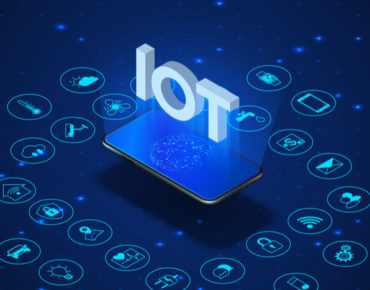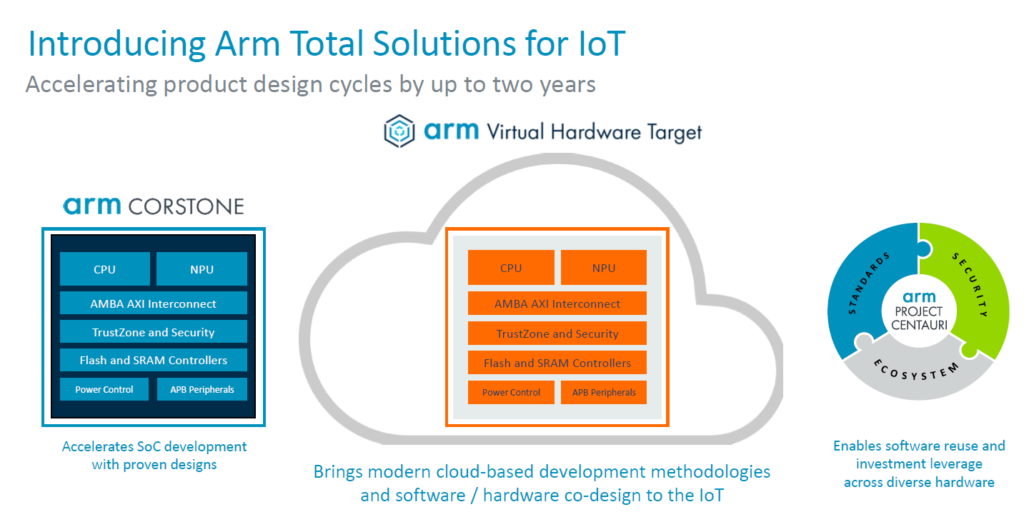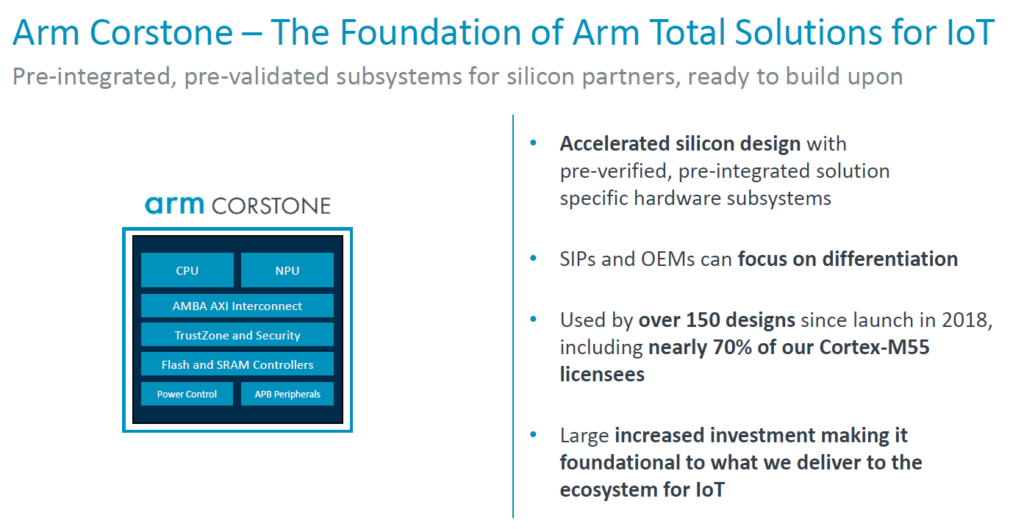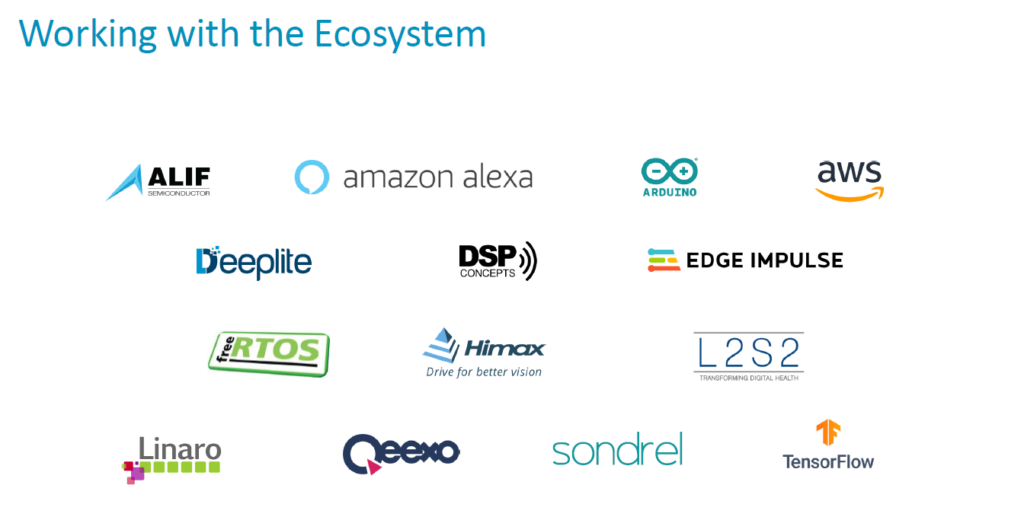Arm Says Its New Cloud-Enabled IoT Platform Carves 2 Years Off IoT Product Development

As IoT has soared in adoption and use, the IoT development process has stubbornly fallen behind, still requiring up to five years between a product concept and its eventual development and release on the market.
That is not helping Internet of Things (IoT) device manufacturers and developers release new products, but it has been a difficult challenge to solve.
Now Arm Ltd. thinks it has found a better way, with a new Arm Total Solutions for IoT software platform that is built to allow application developers to simultaneously create their apps even while the hardware designers are still imagining their own silicon designs.
By allowing software developers to create apps for non-existent hardware using the new Arm Total Solutions platform, the entire development process can be reduced to three years from its current five-year process, according to the chipmaker. The platform includes a wide range of components that simplify the design process and streamline product development, including hardware IP, physical IP, software, real-time OS support, machine learning models, tools, application specific reference codes and more.
The new platform was announced Oct. 18 (Monday) at the virtual Arm DevSummit, which continues through Oct. 21.
"Think about the impact this could have – a software developer who used to need physical hardware to begin developing an app can now start this work way ahead of silicon availability, saving significant time and costs," Mohamed Awad, vice president of IoT and embedded at Arm, said in a pre-briefing with journalists last week. "With these new tools, ML developers do not have to become embedded developers to deploy intelligence onto IoT devices. They can use virtual hardware to optimize models in the cloud – the same way those same ML developers optimized models for other markets."
At the same time, IoT service providers will not have to build and maintain hardware farms to scale their services across a diverse set of devices, he said, because they will be able to run continuous integration workflows and verify their algorithms on virtual hardware, allowing them to achieve scale.
The new platform is built on the foundation of Arm's proven Corstone validated and integrated subsystem, which has been used for the last several years by Arm silicon partners to accelerate their time to market for more than 150 designs, according to Arm.
 Also included in the new platform is Arm Virtual Hardware Targets, which is designed to give software developers, OEMs and service providers a new cloud-based service that delivers a virtual model of the Corstone subsystem to enable software development without the need for physical silicon. That is what allows Arm Virtual Hardware to bring modern agile software development methodologies like continuous integration / continuous deployment (CI/CD), DevOps and MLOps to IoT and embedded platforms, without having to invest in complex hardware farms, said Awad. Arm Virtual Hardware is available on AWS Marketplace.
Also included in the new platform is Arm Virtual Hardware Targets, which is designed to give software developers, OEMs and service providers a new cloud-based service that delivers a virtual model of the Corstone subsystem to enable software development without the need for physical silicon. That is what allows Arm Virtual Hardware to bring modern agile software development methodologies like continuous integration / continuous deployment (CI/CD), DevOps and MLOps to IoT and embedded platforms, without having to invest in complex hardware farms, said Awad. Arm Virtual Hardware is available on AWS Marketplace.
Also new and part of the platform is an Arm ecosystem initiative called Project Centauri, which is designed to drive the standards and frameworks needed to grow serviceable markets and scale IoT software innovation, according to the company. Project Centauri is built for use with the Cortex-M chip line. Project Centauri delivers foundational standards for software packaging and delivery, and for how cloud services can access key on-device features. It includes aspects of device security, like TF-M (Trusted Firmware), and PSA Certified.
"We are going to enable millions of developers all over the world to accelerate time to market, adopt more modern software development methodologies, and to easily innovate for all of the diverse, diverse hardware that makes up the IoT, said Awad. "We are going to fundamentally transform how software is developed for IoT, and in the process, the economics of the market."
Arm Total Solutions for IoT is available now and addresses general-purpose compute and ML workload use-cases, including an ML-based keyword recognition. Also available now is Arm Virtual Hardware Targets for multiple configurations of the Arm Corstone-300 subsystem from Arm SoC partners, incorporating the Arm Cortex-M55 processor and Arm Ethos-U55 microNPU (neural processing unit).
"The foundation of Total Solutions for IoT is Corstone," said Awad. "It is designed to enable SIPS (strategic integration partners) and OEMs to focus on differentiation by bringing together CPUs, MPUs (memory processing units) and system IP and other key technologies into pre-integrated, pre-validated subsystems that just work. So, moving forward, it will be foundation to how we deliver IoT technology to the ecosystem. Everything we do will start with Corstone."
 The Arm Virtual Hardware component will be a critical part of the platform, said Awad, giving developers the ability to make their critical work easily and widely available in the cloud. "What is so great about Arm Virtual Hardware is that we are optimizing and streamlining the technology specifically for modern cloud-based development," he said.
The Arm Virtual Hardware component will be a critical part of the platform, said Awad, giving developers the ability to make their critical work easily and widely available in the cloud. "What is so great about Arm Virtual Hardware is that we are optimizing and streamlining the technology specifically for modern cloud-based development," he said.
"By enabling parallel hardware and software co-design and bringing new cloud native development benefits to IoT, we are enabling software development to begin well ahead of silicon availability," said Awad.
For example, in a machine learning DevOps workflow for neural network optimization for edge, it can now be done using virtual hardware that is all in the cloud, without the need for a physical hardware farm, said Awad.
"The software development process and the continuous integration all happens in the cloud in the middle," he said. "And then finally, when your software is ready, you can move it to a binary image and deploy it on the devices fleet. This level of optimization across the workflow increases productivity enables new entrants to participate in the market and accelerates innovation."
Several Arm partners are already using the platform on projects of their own, he said, including Amazon's Lab126, which is using virtual hardware to scale Alexa wake-word testing, as well as Himax Technologies, which is using Arm Total Solutions to accelerate development of their new AI processor and making the specific Arm virtual hardware configuration of the new processor available for developer use before silicon availability.
These are all capabilities that Arm partners have been asking for, said Awad.
"It is early days, this is really the start of a journey that we are going on," he said. "As we move forward, we are absolutely going to look to bring more partnerships onboard, more IP, whether that be Arm IP or otherwise and expand upon this.
Bob O’Donnell, principal analyst with TECHnalysis, told EnterpriseAI that Arm's notion of allowing IoT developers to now virtualize their hardware in the cloud without needing access to the actual chip or development boards is important.
"The ability to be able to do that allows a much wider group of programmers to get into this," said O'Donnell. "The other thing is they are allowing people who are building these modern native apps to get access to IoT based hardware, which in the past, they could not do."
What also makes the new Arm platform intriguing is that it includes plenty of built-in security, which is the "kind of basic nuts and bolts stuff that nobody likes to do," said O'Donnell.
"Look, IoT is still hard," he said. "And it is still going to take a while for all this stuff to pan out. So, by building things that are open source, while using modern software development tools and methods and then virtualizing the hardware, they are trying to remove whatever barriers they can to let more developers and companies have access. That ultimately should drive higher levels of adoption and more IoT based applications."
What makes it promising is that Arm can do this because they are at a low-level in the process because of their silicon work, said O'Donnell. "It is an intriguing thing. But the fact that they are making the process significantly easier and opening it up to a different type of developer than ever used to work on IoT stuff, those are a big deal. That is an important step."














